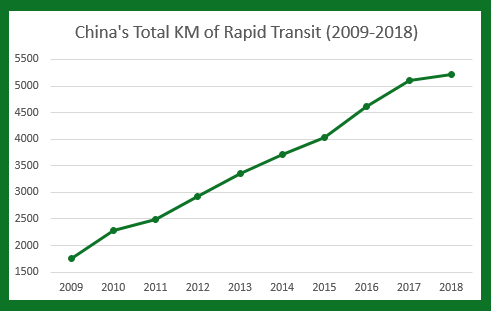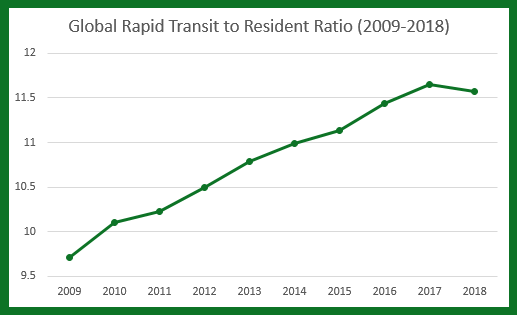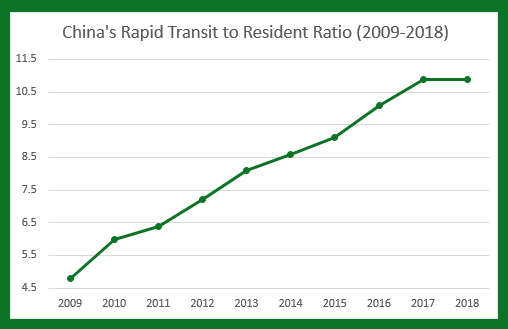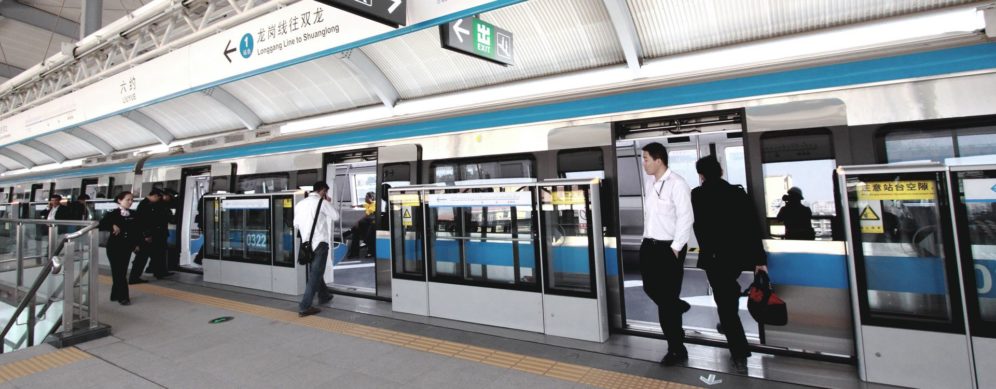July 26, 2019
In 2018, China’s Transit Boom Subsides, Scaling Back Growth Worldwide
For the first time in over a decade, growth of rapid transit slows, mainly due to the waning of rapid transit in China.
Each year ITDP performs a survey of global transport to create a Rapid Transport Database. The data is collected from government sources or publicly available news sources.
Every year for the past 12 years, there has been over 650 kilometers of new transit built globally. However, in 2018 only 343 kilometers of new transit was built, leading to urban population growing faster than rapid transit for the first time since 1998. The overall decrease is in part due to less rapid transit construction in China, where both the number of cities with rapid transit projects as well as the size of ongoing projects has decreased.
China’s dominance recedes
China’s boom ebbed in 2018. Previously China’s rapid transit growth, particularly of metro, greatly surpassed that of other countries. However, in 2018, China’s metro expansion made up just under half of the world’s metro expansion – a significant decrease from previous years. Despite the substantial gains made by China in the past decade, its Rapid Transit to Resident (RTR) ratio of 10.9 remains just below the global average of 11.5. The RTR is a metric that compares total kilometers of rapid transit (including BRT, LRT, and metro) with the country’s urban population (cities with populations over 500,000). While China’s RTR has more than tripled in the last twelve years, growing from 3.2 in 2006 to 10.9 today, more transit has to be built for China’s RTR to match its population. Other forms of transit, such as BRT, may provide another path forward. For example, Ecuador nearly doubled its RTR from 10.8 to 19.2 in just 5 years through a heavy investment in BRT.

RTR ebbs for first time in 20 years
Thanks in large part to China’s massive increase in rapid transit, the global RTR has increased from 9 in 2006 to 11.6 in 2017. However, in 2018, the global RTR decreased for the first time since 1998, dropping to 11.5. This indicates that transit has not kept pace with urban population growth in the last year. While this drop is small, it could signal cause for concern. Says Jacob Mason, Research Director at ITDP, “We hope this is a wakeup call for governments to step up their work on rapid transit. Rapid transit improves access, supports walkable transit-oriented development, and reduces pollution from private vehicles. We call for governments to do the hard work of moving transit projects forward.” While the long term trend is still positive, the outsized impact of China may mask a lack of growth in transit in other contexts.
Says Jacob Mason, Research Director at ITDP, “We hope this is a wakeup call for governments to step up their work on rapid transit. Rapid transit improves access, supports walkable transit-oriented development, and reduces pollution from private vehicles. We call for governments to do the hard work of moving transit projects forward.”


Looking to Next Year
The question remains – who will take the lead now? Ethiopia, Iran, Malaysia, and Panama have all opened significant expansions of their rapid transit systems in the past five years, and others have large-scale plans in the works. The continent of Africa, where many countries have some of the fastest growing populations worldwide, saw a new metro project open up in Abuja, Nigeria, the first in West Africa and rare in the region. This project is notably financed by loans through the Exim Bank of China. Mason adds that with rapid transit it’s important to consider the pros and cons of different modes, “Metro expansion is expensive, time consuming, and complicated, so many governments can only build small metro systems in their biggest cities. Other rapid transit modes like light rail and BRT can provide similar results in a much shorter timeframe and at a fraction of the cost. To address the rapid growth of cities and address the looming threat of climate change, we need to act quickly using all the tools we have.“

As projections point to almost half the world’s population moving into urban areas in the next century, the urgency for rapid transit is only increasing. Without rapid transit and sustainable development that connects people to destinations without the reliance of personal vehicles, this trend proves concerning. Mason adds, “We can only hope that this is not a sign of things to come.”

